Menus
- Double-dealing !
- Long announced, the Yamaha YZF-R3 Yamaha is finally out of the woods and completes the sport range of the Japanese manufacturer, halfway between the YZF-R125 and the R6. A nice little motorcycle, accessible to A2 licenses, which literally seduced us with its simplicity and great efficiency…
- Discovery
- In the saddle
- In the city
- Motorways and expressways
- Departmental
- Comfort
- Circuit
- Braking
- Consumption
- Conclusion
- Optional equipment
- Rivals
Double-dealing !
Long announced, the Yamaha YZF-R3 Yamaha is finally out of the woods and completes the sport range of the Japanese manufacturer, halfway between the YZF-R125 and the R6. A nice little motorcycle, accessible to A2 licenses, which literally seduced us with its simplicity and great efficiency !
It was in Spain, on the road and circuit, that we met this new mid-size sports car, the designated rival of the KTM RC390 and Kawasaki Ninja 300, but also of the Honda CBR500R, currently barely more expensive (300 €). . This in the absence of a hypothetical CBR300R which could, as in other European countries, have replaced the late CBR250R.
Manufactured in Indonesia, the R3 does not sell for all that and can even appear expensive compared to other A2 models from the same manufacturer, such as the 689 cm3 MT-07 roadster, sold for € 5,999 without ABS. In fact, it is this whole category of mid-size sportswomen that can appear a little overrated in the eyes of less and less fortunate clients, especially young people allowed..
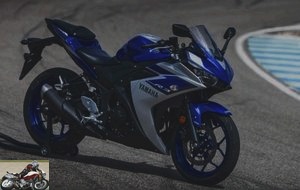
Discovery
Descendant of a long line of Yamaha sports cars, the R3 had to take advantage of this aesthetic affiliation, if only to fit naturally into the existing range. It therefore takes up the aesthetic codes of the YZF-R family, with a beautiful sharp front face with double optical headlight separated by an air intake and surmounted by an LED position light, a fairing with harmonious and protruding lines, a long and narrow gas tank, a slender and raised rear, beautiful multi-spoke alloy rims and an exhaust silencer in low position.
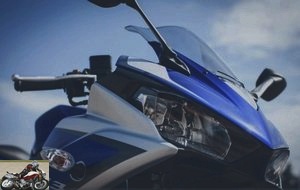
The level of equipment is very correct, but not excessive. For the price, we would have liked to be able to benefit, as is the case for the YZF-R125, from a beautiful inverted fork (here a classic 41 mm KYB telescopic fork) and radial caliper braking ( here conventional). Same observation at the level of the frame, of tubular diamond type in steel rather than Deltabox, associated with a long swingarm, also steel and a monocross type suspension, with adjustable shock absorber in preload. ABS is fortunately included as standard on this model, but it cannot be disconnected.
On the engine side, Yamaha is launching an all-new 321cc inline-twin with 42 hp at 10,750 rpm, and 29.6 Nm of torque at 9,000 rpm. An engine with double camshaft (direct drive) and 4-valve cylinder heads, which also features case-hardened connecting rods, forged aluminum pistons (lighter) and DiASil aluminum cylinders with high silicone content (20%). These cylinders are slightly offset (7mm) to reduce friction and oil consumption. The crankshaft, with a simple balancing arm, is for its part set at 180 ° in order to limit pumping losses and increase performance.
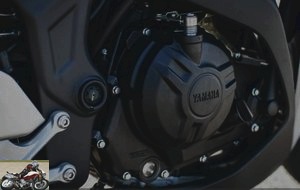
In the saddle
Easy to access, with its seat height of 780 mm, the R3 delivers very quickly. The overall build is rather compact, with a contained weight of 169 kg in running order (20 kg less than an R6) and a relatively low center of gravity. The controls are naturally handy, but the brake and clutch levers are not adjustable in spacing.
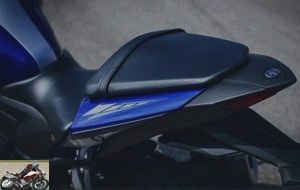
The high-placed half-handlebars demonstrate, if need be, the mixed sport / touring positioning of this Yamaha R3, just like the lightly padded rider’s seat and the slightly back footrests which induce a riding position not tilted far forward. . If the apparent quality of the former (surface treatment) may seem a bit tight, that of the footrests and footrest plates is on the other hand of good quality, significantly improving the perceived quality of the whole.
The on-board instrumentation is compact and well designed, with a large analog tachometer and a digital dial displaying a number of useful information (fuel and water temperature gauges, clock, gear indicator engaged, tachometer, odometer and daily trips, remaining range, as well as average and instantaneous fuel consumption. An adjustable shift light is even provided, as on the sharpest sports cars.
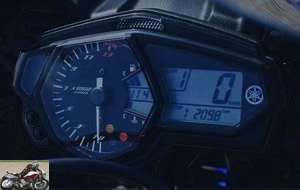
The mirrors provide a decent rear view and are easy to adjust, both in gauge and tilt. Carrying a passenger is of course possible, but the domed seat of the rear folding seat and the high position of the passenger footrests will certainly not suit everyone, especially since only a saddle strap is provided to keep it in place. position. Note that a (very) small storage space is located under this appendix. The 14-liter fuel tank has a pretty aviation-style hinged cap, which opens as usual with the ignition key. A headlight trigger is also available on the left index finger.
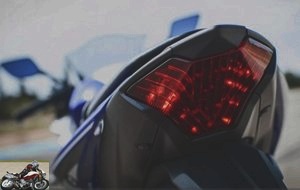
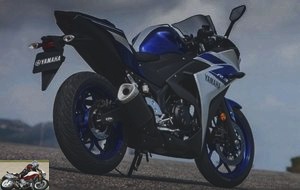
In the city
Contact, starter, the Yamaha twin-cylinder snorts with one of the most discreet sounds. A few light strokes of gas are not enough to make him express his character, but by turning the handle more frankly the melody becomes much more garish and promising. Obviously, it’s in the towers that it happens…. First, take off gently behind our opener and off we go for a photo shoot in the city, followed by a ride of about 50 km towards the reliefs, then to the Calafat circuit for the track session.
From the outset, the R3 is stable, neutral and homogeneous, very easy to steer with a well-placed front axle and offering good feedback to the handlebars. The driving position is rather comfortable, with not too bent legs and little pressure on the wrists. The clutch is flexible and very progressive, the gears stacking with rigor and precision, even without systematic use of the clutch.
The balanced weight distribution (50/50) and the 25 ° column angle give the R3 good handling and excellent agility, but without excessive liveliness. In town, take advantage of a correct steering angle (34 ° on each side) to get out of the congestion without too much effort and make a U-turn quickly if necessary.
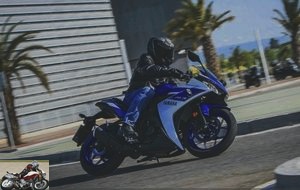
The Yamaha twin-cylinder easily accepts cruising on a trickle of under-revving gas, from 1500 rpm in 4th, past 2000 rpm on all other reports, even 6th “overdrive” report. This is good for moving smoothly and quietly in this urban context, but thus impossible to obtain effective acceleration or recovery. Like many “small” motorcycles, the R3 requires a high engine speed to get out of its torpor..
By pulling the gears longer, the engine sound changes dramatically and we begin to perceive the sporting potential of the Yamaha twin-cylinder. Linear, but very determined in its revving, it climbs briskly through the revs, to the limits of the tachometer and its red zone established between 12,500 and 13,500 rpm. Nice, but not in town…. where we quickly adopt a much wiser pace.
Motorways and expressways
Out of the urban context, we can finally push our investigations and box reports a little further. On the motorway, the R3 shows good stability at high speed, its screen and its fairing sides offering the rider protection that is certainly insufficient, but not negligible. The suspensions do their job properly, effectively absorbing the biggest shocks and contributing to driving pleasure in this context. The R3 confirms its versatility here, showing that it is also capable of swallowing medium-sized peri-urban journeys on expressways and highways without too much discomfort..
At a steady speed, here 120 km / h maximum, the Yamaha twin, on the other hand, distils insidious vibrations at the level of the handles and footrests. The tachometer needle oscillates between 7000 and 9000 rpm depending on the gear chosen, 6th overdrive most of the time, 5th when it comes to getting a more effective boost when passing. On the famous German highways, not limited in speed, colleagues would have reached 187 km / h in 6th gear at more than 12,000 rpm, which seems more than plausible to us..
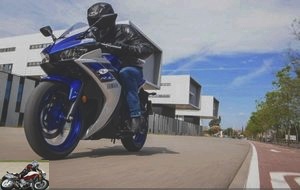
Departmental
By taking the small steep roads of the hinterland, the R3 still seduces with its consistency and behavior as intuitive as it is reassuring. Easy and precise when entering a curve, it does not require significant effort to switch quickly from one angle to another and easily accepts a sporty driving rhythm.
Well whipped, the Yamaha twin comes out of this exercise with honors, responding to the slightest demand on the accelerator, as long as the tachometer needle oscillates above 7000 rpm. The short first gear ratios contribute favorably, with a screaming second in the hair and an edgy third as soon as a stretch presents itself. No time to be idle on these presentations ….
By further forcing the pace, the heading precision remains good, but we begin to feel the work of the frame when passing a constraint or when we accentuate the effort on the handlebars a little too much when changing gear. sharp angle. Fortunately, the suspension works well and allows the R3 to maintain precise handling and good traction on the go-around. The ground clearance is excellent, especially since the Yamaha technicians have chosen to remove the lugs from our footrests..
Despite a certain mistrust of them for the first kilometers, we have to admit that the choice of the original Michelin Pilot Street tires is not incongruous. These tires, which according to Michelin would have a longevity increased by 30% compared to competing models (Bridgestone Baltlax BT90, Pirelli Sport Demon….), Indeed reacted rather well to our repeated assaults and to traces of residual moisture crossed on the road. ‘angle. They have of course experienced some small loss of grip here and there, but never suddenly or without warning.
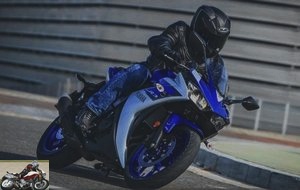
Comfort
Halfway between a road and a sport, the R3 hopes to offer the best possible compromise between these two worlds. The result is quite satisfactory on the driver’s side, with a not too restrictive driving position, good height half-handlebars, good suspension comfort, as well as a relatively comfortable seat due to a well-padded saddle. On the other hand, the passenger will be less satisfied with its narrow and rounded seat, or its high perched footrests and the few support possibilities offered..
Circuit
Arrived at the Calafat circuit (3250 m route), we put on our leathers for two twenty-minute sessions on the handlebars of our standard R3s. We thought we could try the Cup version, equipped with an Akrapovic competition line and various accessories, but it was not present on site. It will be sold to the participants of the European R3 Cup, of which the 7 events will take place very soon in France, from May to September 2015.
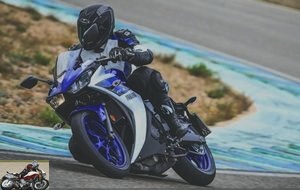
After two scouting laps of the circuit at moderate speed, the dogs are let loose, some being more voracious and in a hurry than others, more cautious by nature. As the pace increases from lap to lap, the grip limit of Michelin Pilot Street tires becomes easier to pinpoint, obvious to some…. However, these tires with the road profile are no less effective in this context and accept generous angles without stalling too suddenly when flirting with the limit. Frankly, it does it well and there is plenty of way to have fun without too many sores on the track.
Swung manly from one angle to another in the sequences, the R3 calmly suffered our outrages. Barely hardened when preloading the shock absorber spring, it retains good rigor in the sequences and on the angle. The limits of the chassis are noticeable, but all you need to do is adopt a more streamlined riding style to stay on track and not make mistakes. The space allotted to the pilot makes it possible to quickly change his driving position depending on the route, swaying and forward in a curve, backing up and lying hard with the tank in the stretches, in search of speed.
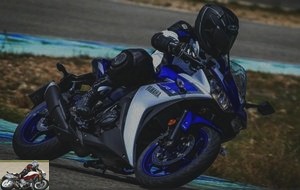
Braking
Equipped with a 298mm floating disc with 2-piston caliper up front and a 220mm rear disc with single-piston caliper, the R3 may appear to some to be slightly under-equipped and lacking in bite. However, we have to admit that this configuration proved to be sufficiently effective during this test, even on the circuit..
The front brake indeed has a good feeling to the lever and delivers convincing power when the lever is fully applied, without too much accidental triggering of the ABS. The power comes in fact gradually, proportional to the pressure exerted on the lever.
The rear brake pedal is often more difficult to adjust, with a faster intervention of the ABS if you press too sharply, but you can quickly take the measure, which allows to better balance the braking when looking optimal efficiency.
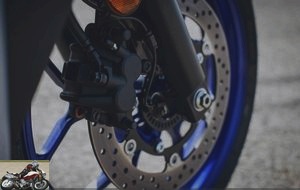
Consumption
As is often the case during these short tests, we can only rely on the average consumption indicator to assess the consumption of the Yamaha YZF-R3. This indicated an average of 4.7 liters / 100 km at the end of our test drive, so we can estimate the range of the R3 at nearly 298 km including reserve. Rather reasonable fuel consumption, accompanied by a handy automatic chain tensioning system and valve clearance control pushed back to 42,000 km.
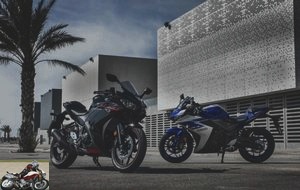
Conclusion
Well born, despite the lack of an inverted fork that would have given it a little more appeal, the Yamaha YZF-R3 more than deserves our attention. Versatile, it is indeed capable of ensuring your daily trips as well as your Sunday walks, while ensuring very good performance on the road and circuit for thrill seekers. Only its price, yet close to that of its direct rivals, could make a young A2 license hesitate to have a more powerful and barely more expensive motorcycle, initially restricted to 35 kW, but later released without big extra cost.
Strong points
- Virulent engine
- Versatility
- Maneuverability
Weak points
- No inverted fork
- Vibrations
- Price
The technical sheet of the Yamaha R3
Optional equipment
- Akrapovic exhaust line (circuit)
- Akrapovic silencer protection
- Seat cover
- Plate holder
- Engine guards
- Sport bubble
- Stickers
- Tank guards
- LED turn signals
- Luggage storage
Rivals
- Kawasaki Ninja 300 R – inline twin 296 cm3 – 39 hp – € 5,499 ABS (€ 4,999 without ABS)
- KTM RC 390 – 373.2 cc single cylinder – 44 hp – 5790 € with ABS
- Honda CBR 500 R – inline twin 471 cc – 47.6 hp – € 5,799
Related articles
-
Six cylinders in line, 1649 cm3, 160 hp at 7,750 rpm, 175 Nm at 5,250 rpm, 336 kilos, from 23,250 € A stylish “Kalt” way of cruising made in Germany How…
-
Little pearl of Asia Introduced in 1984, the Honda 500 VF came at the start of the wave that saw Honda bet everything, or almost everything, on this…
-
A new little sports car accessible to A2 licenses Twin cylinder in-line, 399 cm3, 45 hp at 10,000 rpm, 38 Nm at 8,000 rpm, 168 kilos, from € 5,999…
-
Sporty for big cube bikers The Kawasaki 300 Ninja succeeded the 250 Ninja in 2013. While the 250 was a nice little bike, the 300 underwent a bodybuilding…
-
Authentic sensations Ducati knows how to offer models that transcend its history, such as its Monster, in its range. The success of the latter is based…
-
The Z ReviZitee From the top of its eleven Z’an, the Z rolls mechanics and adopts a new look which is scary . For this new model, the manufacturer…
-
The noon demon Revamped and streamlined version of the Duke 125, the RC 125 arrives in our cities with its muscular frame and air of medium displacement….
-
A remarkable entry for KTM in the most profitable segment of the market Inline twin, 799 cc, 105 hp at 9000 rpm, 87 Nm at 8000 rpm, 169 kilos, from ¤…
-
Moto Guzzi California Aquila Nera test
The stripped down version of the Calif ‘for 3000 euros less If for you the California evokes the motorcycles of the American police, you will be…
-
Honda NC 700 X motorcycle test
Transgenic camel Discovered at the Milan Motor Show, the Honda range is enriched with a new range of 3 midsize machines, available on the same chassis…
No indeed, Kawa didn’t need to wait for euro4 to make yucky silencers on his Z1000
I think that this kind of motorbike is more rewarding than a 300, 400 or 600, hence the fact that people are interested in it, even if it is not really the best of calculations 🙁 Well if that please, good for them
I don’t find the driving convincing, but it’s interesting.
I confirm that the CB650R is a purge in A2. Not so much at low revs, due to its condition of 4-legged honda of medium displacement, it is more than polished. But from the mid-range, you feel that it is sluggish. In addition, it takes 130 а knock.
Engine without any interest in 47 and a half horsepower. The motorcycle also completes. The remark is valid for all these moulbifs cut off by half of their power. And again, the arpetes, you escaped the Moulins of 106 bourins brides in 34 hp !!
z900 !!! that said, she looks really good!
The ad was supposed to talk about the H9 10 years ago …
The Z900 is an average bike in chassis / ergonomics. Its engine is at the top.
Apart from elastic suspensions out of settings, the MT09 has improved.
Finally, the new Triumph Street Triple with its block passed to 765 is THE success of the segment. Its three cylinder is even more pleasant at any speed than that of the Yam ‘.
La Suz ‘? Poor. The GSR 750 was more pleasant.